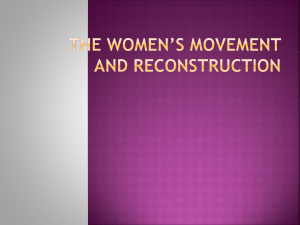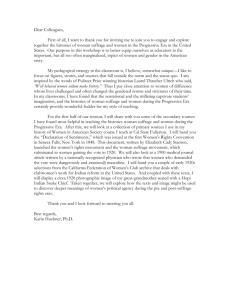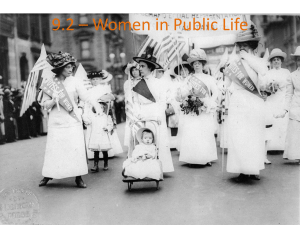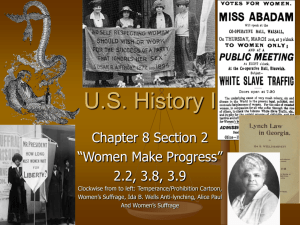p
advertisement
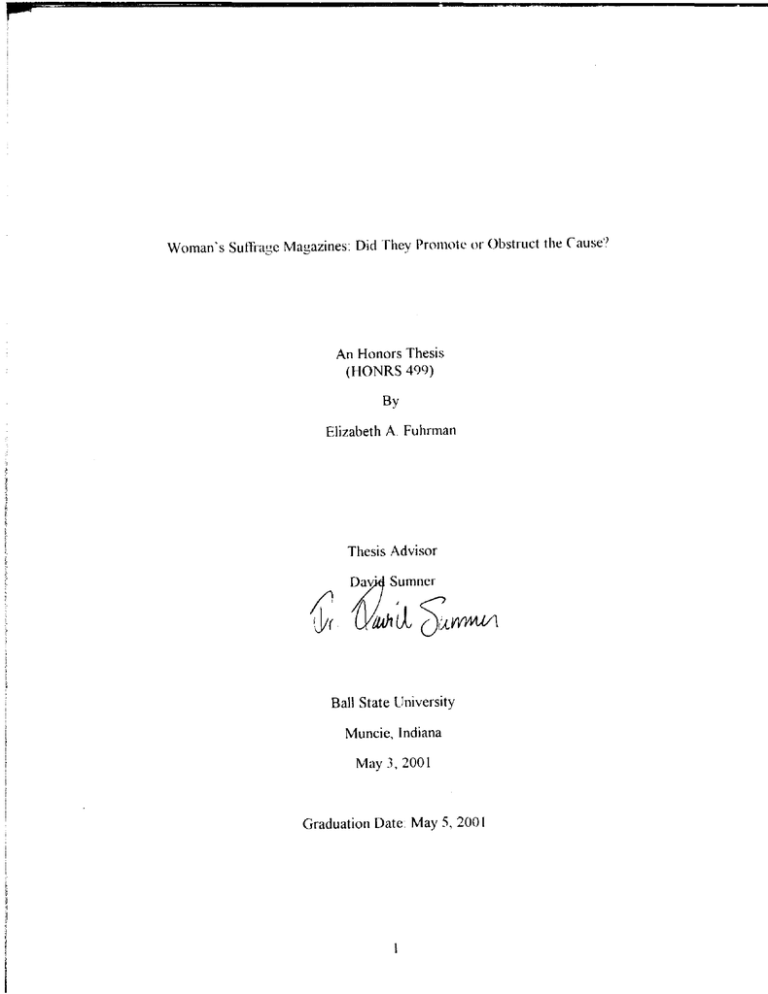
p
Woman's Sum"age Magazines: Did They Promotl' or Obstruct the Cause')
An Honors Thesis
(HONRS 499)
By
Elizabeth A. Fuhrman
Thesis Advisor
Ball State University
Muncie, Indiana
May 3,2001
Graduation Date May 5, 2001
Abstract
This thesis focuses on woman suffrage magazines and how they influenced the
right to vote. Three factors are necessary in explaining the movement: the history of the
woman's suffrage movement in the United States, the general history of magazines, and
the development of women's suffrage magazines particularly, T7Je Lily, the Womall's
JOllrnal, and The Womall's Citizen. The histories of each of these magazines was
explored in order to explain the specific effects magazines had on the woman's suffrage
movement.
3
,
~f:
Acknowledgments
I would like to thank Dr. David Sumner from the journalism department, for his
encouragement in finding a creative thesis idea in the magazine field and advising me on
my thesis. I would also like to thank him for his countless advice in the magazine field and
sharing his knowledge of magazines with me. Dr. Sharon Seagar from the history
department should also be thanked because she was instrumental in providing my
foundation in woman's history and helped me to organize my thoughts.
Without the continually support of my family, friends, and Frank, I would not have
this thesis completed today. Thanks for listening, understanding, and pretending to like
history.
2
Women have always been known for their communication skills. They have often
gathered in social groups such as quilting bees, church organizations, or just simple tea
parties in order to share the news of the community and spread information to other
women around them. In order to reach a mass audience, women had to search lor an
effective source to get their message across. Women needed the media to do this.
More than 10,000 magazines exist on the market today, and the vast majority of
magazine readers are women. In addition, many more magazines exist specifically aimed at
women than at men. In order to understand the impact women's magazines have on
women today, it's important to be knowledgeable of the woman's rights movement, the
evolution of magazines, and the development of women's suffrage magazines. These
factors help to explain why women had to find their own effective form of media to
communicate. Also, the woman's suffrage movement is a key time period in which women
emerged as true journalists.
To fully understand how women's suffrage magazines and the light for woman's
right to vote are both linked together, it is important to study the growth and change of
both separately. To trace the beginning of the woman's suffrage movement in the United
States would be virtually impossible, because women have been lighting since the United
States was founded to have equal rights as men. According to women's historian Nancy
Woloch, 'The greatest testimony to the symbolic power of the vote, to both supporters
and opponents, was the length of the fight to achieve it, longer than any comparable
reform campaign and certainly longer than any other campaign for an electoral reform"
(Woloch 332). Woloch also said women gaining the right to vote was not the only benefit
of the movement. The suffrage movement drew women together as one political unit
aimed at fighting one common cause. Women began making addresses, holding
conventions, printing petitions and resolutions, lobbying, and creating new forms of media
that address issues related to their cause.
4
The formation of an organized call for woman's suffrage began with a woman's
convention in New York state. In 1848, the Seneca Falls "Declaration of Sentiments,"
given at this convention, included a broad spectrum of grievances and demands, including
the first demand for the right to vote. During the Civil War, women put their energy into
the abolition movement and woman's rights came after the need for the vote for the black
male, since the African American race was actually dying for their freedom. Suffragists
realized their fight was of similar but different needs, and they would have to fight
separately from the black male for their right to vote. In 1869, moderates in the woman's
movement joined the American Woman Suffrage Association, led by Lucy Stone, while
the radical faction formed the National Woman Suffrage Association, organized by Susan
B. Anthony and Elizabeth Cady Stanton. By 1890, the growth of higher education for
women and of women in the workforce revitalized the movement and caused the
unification of the two organizations under the name the National American Woman
Suffrage Association (NAWSA) The new NAWSA "streamlined its operations" and "ran
more formal conventions, attended by delegates from state organizations; it ended internal
debate; and it became more professional, especially in tactics and propaganda" (Woloch
341 )
After 1896, Congress no longer considered a woman's suftfage amendment, so the
NA WSA directed its efforts toward winning the right to vote at the state level. "These
campaigns usually failed--between 1896 and 1910 not a single state granted women the
vote" (Woloch 341) Membership levels continued to climb across the nation, and a new
generation ofleaders emerged with Anna Howard Shaw acting as president ofNAWSA
from 1904 to 1915 and Carrie Chapman Calt serving as president from 1900 to 1904 and
1915 to 1920. The organization became largely a propaganda tool, promoting through
hearings, speeches, and suffrage publications, the benefits women would bring to the
country if they had the right to vote and as a way to fight the large anti-suffrage
movement.
5
The turning point came after 1910, when the woman's vote was endorsed by the
Progressive party, the General Federation of Women's Clubs, and a string of western
states (Woloch 355). Influenced by President Woodrow Wilson's support of woman
suffrage, by the NAWSA's large membership, and by woman's support in the World War
I war effort, the House of Representatives finally passed a woman suffrage amendment on
January 10,1918 and the Senate approved it in June 1919 (Woloch 359). Three-fourths of
the states needed to ratifY the amendment for it to become into effect. Fourteen months
after the Senate suffrage vote, on August 26, 1920, the 36th state, Tennessee, ratified the
amendment, and the woman's enfranchisement was finally legal nationwide (W oloch 360)
Throughout the woman's suffrage movement, magazines became an important link
in getting the different associations' messages out. Magazines were a medium to reach the
nation, but as the movement was evolving so were magazines. The debate over how
effective magazines are will probably never end. Whether they positively affect the public
or negatively influence the public, magazines have played a part in the formation of key
events in history. Magazines "were the means for constructing and maintaining shared
sensibility, collective action, and allegiance among women who were, at the least,
geographically and socially isolated" (Steiner 66). Probably one of the most important
roles it played was during the woman's suffrage movement.
To the publishing industry the nineteenth century became known as the golden age
of magazines (Mott 5, Vol 3). "To the women's suffrage movement, magazines provided
a new opportunity to reach and influence a large, diverse, and geographically separated
audience" (Jolliffe 126). During this century, women became key consumers of household
goods, and they gradually expanded their concerns trom strictly family affairs to the world
beyond their households (Jolliffe 125). Women's magazines became part ofa growing
trend of nationalism promoting "all things American" and what the cultured woman should
have (Jolliffe 127) Edward Bok, editor of the Ladies' Home Journal from 1889 to 1919,
was quoted in the Womans' Column as saying in 1890 that '''an examination of
6
subscription lists of magazines' showed seven-eighths of the subscribers to be women- an
almost incredible figure even when we realize how many of the big-circulation periodicals
were among those designed for women and the horne" (Mott 353, Vol 4).
Magazines also grew during this time not just because of an economic shift, but
because of postal changes and technological advancements. Postage rates were lowered
continually through the nineteenth century, but the most important postal changes carne in
1885 when the postal rate dropped to I cent per pound and inl897 when the rural free
delivery system was instituted. Both postal improvements helped women's periodicals
reach every corner of the nation, and circulations rose to the millions (Johnson and Prijatel
70). The audience changed from just the "prosperous urban professional" who before had
been the primary audience to developing magazines designed for the "average working
man and women" (Johnson and Prijatel 70). With national circulations, magazines then
drew greater advertising revenues, which helped to defray expenses that were originally
charged to the subscribers (Jolliffe 127)
[n
addition to the postal changes, the end of the Nineteenth Century brought mass
production methods such as "timed production scheduling, conveyor systems, and
assembly lines" (Johnson and Prijatel 71). This century also introduced the linotype
machine in 1885, which eliminated the need to set type by hand. In 1886, photoengraving
allowed the inexpensive reproduction of halftone photographs and in 1887, monotype
arrived. "In 1888, photographic film became available to replace the more expensive and
awkward plates" (Jolliffe 127). The first successful color printing process in the United
States for large-scale press runs occurred in 1893.
Another trend affecting magazines was the field's turn toward specialization during
the early twentieth century. Instead of magazines just aiming for the readership of all
women, magazines emerged focusing on certain issues like temperance or suffrage.
Women began starting magazines in areas important to them and readers interested in that
subject flocked to them. To reach a large audience women needed the media and they had
7
The move to Ohio seemed to be advantageous for The Uly in that access to new
type allowed the magazine to become more visually appealing. With this move to Ohio,
the circulation of the magazine also increased from 4,000 to 6,000 copies (Bloomer 156)
But, with Bloomer aging, her husband selling his newspaper, and the incapability of
printing and mailing a large circulation magazine 3,000 miles away from the nearest
railroad, Bloomer was ready to sell The Lily. The magazine died out a few years after it
was sold, but Bloomer proudly defended her work:
... But this much is true, it did not die of 'fun poked at it.' It had long
outlived fun and ridicule and was highly respected and appreciated by
its thousands of readers. It had done its work. it had scattered seed that
had sprung up and borne fruit a thousandfold. Its work can never die.
You say rightly that the Lilv was the pioneer journal in the Northwest
for woman's enfranchisement. Other journals have taken its place. and
the movement has gone steadily forward and nears its final triumph
(Bloomer IR7-IR9).
Bloomer could be recognized as the pioneer behind the development of a new
genre of magazine, known as women's advocacy magazines. Bloomer also opened her
pages to young women writers who were just beginning their careers as writers and
reformers While 'lhe Lily published contributions from many well-known reformers, it
also served as a training ground for inexperienced female writers (Endres and Lueck 183)
At its peak, The Uly boasted a circulation rate of six thousand, higher than that of some
popular magazines for both men and women and any other advocacy magazine that
followed in the nineteenth century (Marzolf 221)
Elizabeth Cady Stanton, Bloomer's contemporary, could probably best tell you
what sort of impact the magazine made on woman's suftfage:
Mrs. Bloomer was publishing a paper at that time called the Lily: a
rather inappropriate name for so aggressive a paper, advocating as it
did all phases of the woman' s rights question. .. When she assumed her
duties. the improvement in the appearance aud condnct of the office
was generally acknowledged. A neat little room adjoining became a
kind of ladies' exchange. where those coming from different parts of
the town wonld meet to talk over the contents of the last /,iI, and the
progress of the woman' s-suffrage movement in general. Those who
cl~joycd the brief interregnum of a woman in the post office can readily
testify to the loss to the ladies of the village. and to the void felt by aIL
13
[n
1883, Stone and Anthony each received twenty thousand dollars left to them by
Eliza F. Eddy (Blackwell 242). Stone used her share to publish a column and to make up
the annual deficit of the journal The Revolution clearly could not keep up with its
competitor. Like many suffragist journalists, Stanton and Anthony felt pulled in two
different directions, and therefore could not mature as journalists or devote all their time
into making their magazine profitable "Stanton and Anthony greeted the birth of Ihe
Woman's Journal with a public declaration of support, while probably knowing that the
well-funded Boston publication marked the end of their journalistic activities" (Endres and
Lueck 473)
The Woman's Journal had two main weaknesses that dimmed the magazines
etlectiveness One of these weaknesses stemmed from the rivalry with its competitor Ihe
Revolution and the more radical suffrage organization the magazine represented, the
NASA. The rivalry came out weekly in the journal and fiery articles helped to kept the
suffrage movement separated. The journal also singled out anti-suffragists, often times
alienating them more from the movement instead of persuading them to join the suffrage
cause. Women historian and author Jane Jerome Camhi said, "In the suflfagist journals,
reactions to the Antis were obviously biased; at times they were considered
inconsequential, and yet on occasion they were pictured as a real threat" (Camhi 179) The
journal on describing a new national anti-suffrage organization said the organization "will
be received with joy by the promoters of the white slave traffic, the exploiters of child
labor, the liquor interest, the gambling fraternity, and all the enemies of good government"
(Camhi 265). But, Camhi also stated that on occasion the suffragists were more than
generous in describing their opponents siting this passage from the Woman's Journal,
vol 13, no. 10 (March 11, 1882)
They are women as intelligent as philanthropic and as well educated
as those who petition for Woman Suffrage: and there are more of them
(Camhi 2XO).
16
The second weakness of the magazine, like the sum-age movement itseiC is that it
had a middle class bias. While Jlle Rem/lltio/l spoke to working women and their
injustices in addition to middle class women, the Journal failed to break that barrier. When
The Revolution folded at the close of 1870, it was not mentioned in the pages of The
Woman '.I' Journal (Endres and Lueck 474).
The journal was much more effective in bonding women in the movement
together, than it was harmful. The pages were filled with information women were eager
to read and share with fellow women. The information the Journal contained was by no
means as radical as it rival. Its style was aimed at catching the attention of middle-class
female readers, but it did not ignore men, since many men were supporters of the
movement. The magazine was published every Saturday in Boston and Chicago and
covered women's interests in education, industrial news, legal and political equality
particularly with woman's right to vote. The Journal contained departments such as
"Gossips and Gleanings," "Notes and News," "Concerning Women," "Foreign
Correspondence," and "Humorous," which never mixed information with entertainment
pieces. The front pages of the magazine carried news of suffrage activities throughout the
country, but its columns contain articles on broader issues effecting women, such as
dispelling gender bias. Alice Stone Blackwell wrote this about The Woman '.I' Journal in
the biography of her mother:
Not only did the suffragists look to it for news. counsel and
inspiration. but innumerable articles from it were reprinted as tracts
and leaflets and circulated far and wide. It was the great source of
ammunition and infonnation to the friends of the causc. It represented
the Massachusetts. the New England and the American Woman
Suffrage Associations: but as Mrs. Carrie Chapman Catt truly said. "It
was much morc than the organ of any society: it was the Voice of the
woman's movement" (Blackwell HO).
The Womall '.I' Journal did not ettd publication like many suffragist journals, but
found itself in a merger with the Woman Voter, and the National Sutlraxe News to
become [he Womall ('itizell in 1917. The divided factions of the movement combined to
17
form the NAWSA and needed a voice to represent their organizatill" Ih, ',.
"hli,
(wee'''
became this voice. Each ofthe previous publications contributed to the vLlicc of the new
weekly journal. The Woman '.I' Journal brought its long, respected history as well as a
contributing editor, Alice Stone Blackwell; Lucy Stone had died two years before the
merger of the two woman's organizations. Woman Voter was known for its editorial and
graphic excellence, but none of their staff joined the Citizen. The Voter also gave the new
journal access to membership lists of the Woman Suffrage Party in New York City and the
extensive advertising that appeared in their journal. The National SlIffraKe News was best
known for its extensive reporting and the news it brought to its publication. The Citizen
reflected the strengths of each of the predecessor publications, and became a well written,
news oriented, graphically appealing magazine (Endres and Lueck 430).
From the beginning, the weekly enjoyed one major advantage over many other
suffrage publications in that it was well funded by the Leslie Woman Suffrage
Commission. The Commission was made possible by a bequest from Mrs. Frank Leslie, a
New York magazine publisher, to Carrie Chapman Cat! which made Cat! the primary heir
to an estate valued at $1.8 million (Endres and Lueck 429) Not only was Catt responsible
for providing the funding for the Citizen as head of the Leslie Woman Suffrage
Commission, she was the link that brought the three publications together, organizer of
the Woman Suffrage Party in New York City, and president of the National American
Woman Suffrage Association.
7he Woman Citizen reached an influential female audience by sending the
magazine to members of the NAWSA and the Woman's Suffrage Party of New York City.
In addition, the Leslie Commission sent the ('itizcn free of charge each week to the
memhers of Congress (Endres and Lueck 430). The editorial content reflected this
audience helping to "secure votes for women under every flag that floats and its challenge
is to the attention of the general public by right of being the official organ of a group of
2,000,000 women who are demanding exactly that link with the public" (Endres and
18
to retlect the new content and draw more subscribers and advertisers. In 1927, the ('ilizclI
changed its name back to the Woman's Journal and in 1929, also began to ofter short
fiction and articles dealing with investing (Endres and Lueck 433) Although the magazine
was able to increase its circulation to twenty thousand, a circulation of forty thousand was
needed to make the magazine profitable, since the publication could no longer rely of the
Commission for funding ( Endres and Lueck 432). In the end, the Journal became a victim
of the Great Depression, even though both its subscriptions and advertising had increased,
it still couldn't cover the costs.
During the final stages of the fight for suffrage. it was perhaps the
most important journal of all because it reached suffragists in all
statcs--and every person in Congress .. .Its work was not complete. but
that work \vould have to \vait for another magazine and another
generation of women (Endres and Lueck 434).
These three suffrage magazines were all reaching for the goal of encouraging
women to become involved in the movement. Magazines proved to be the best way to
accomplish this goal through the editorial and large circulations the magazines were
distributed to. A subsequent goal of training women journalists also became accomplished
in the process, making the women better writers and marketers and in turn better
suffragists. Without the advancements in magazines, the information produced by the
suffragists would have been greatly reduced, and it would have taken a longer time to get
their movement accomplished. Magazines proved to be the best source of distributing this
information.
20
-
~---Appendix 1
Suffrage Publications in the United States
Dates of
Publication
Frequency of
Circulation
Publisher
Place of
Publication
Editors
Farmer's Wife
1891-1894
Monthly
I.w. Pack
Topeka, KS
Ira Pack, Emma Pack
The Forerunner
1909-1916
Monthly
Charlton Publishing
New York
Charlotte Perkins Gilman
Monthly,
Semimontly
Amelia Bloomer
Seneca Fall, NY,
Mt. Vernon, OH,
Richmond, IN
Amelia Bloomer, Anna C.
Mattison, Mary Birdsall
Monthly
Toledo Woman Suffrage
Association, Matilda
Joslyn Gage
Toledo,OH,
Syracuse, NY
Sarah R.L. Williams,
Matilda Joslyn Gage
Portland, OR
Abigal Scott Duniway
Publication
The Lily
1849-1859
The National Citizen
and Ballot Box
1876-1881
The New Northwest
1881-1887
Weekly
Abigail Scott Suniway
The Pioneer
1869-1873
Weekly,
Seminmontly
Emily Pitts Stevens, C.C.
Calhoun
San Francisco
The Revolution
1868-1872
Weekly
R.J. Johnsotn, J.N
Hallock
New York
Biweekly, Monthly
John Whitbeck
Hasbrouck
The Sibyl
1856-1864
Suffragist
1913-1921
Weekly, Monthly
Congressional Union for
Woman Suffrage,
National Woman's Party
A True Republic
1891-1904
Monthly
Sarah M. Perkins
Emily Pitts Stevens, C.C.
Calhoun
Elizabeth Cady Stanton,
Parker Pillsbury, Laura
Curtis Bullard, W.T.
Clarke
Middletown, NY
Lydia Sayer Hasbrouck
Washington, D.C.
Rheta Childe Dorr, Lucy
Burns, Vivian Pierce,
Sue S. White, Florence
B. Boeckel
Cleveland, OH
Sarah M. Perkins
Circulation
Unknown
less than 1,500
6,000 at peak
Unknown
1,000-2,000
1,250-3,000
3,000
Unknown
5,599 paid,
15,000 free
compies
Unknown
Appendix 1
Suffrage Publications in the United States
publication
Dates of
Publication
Frequency of
Circulation
The Una
1853-1855
Monthly
Western Woman Voter
1911-1913
Monthly
The Wisconsin Citizen
1887-1917
Monthly, Bimonthly,
Quarterly
Publisher
Paulina Wright Davis,
S.C. Hewitt
Western Woman Voter
Publishing Co.
Wisconsin Woman's
Suffrage Association
Place of
Publication
Editors
Providence, R.I.,
Boston
Paulina Wright Davis,
Caroline Healy Dall
Seattle
Adelia Parker
Wisconsin
The Woman Citizen
1917-1927
Weekly, Biweekly,
Monthly
Woman Citizen Corp.
New York
The Woman Voter
1910-1917
Monthly
Woman Suffrage Party
of New York City
New York
Mrs. M.P.Dingee, Helen
H. Charleton, Marilla
Andrews, Lena V.
Newman, Mrs. Henry M.
Youmans
Rose Young, Virginia
Roderick
Minnie J. Reynolds,
Mary R. Beard, Florence
Woolston, Adaline W.
Sterling
Circulation
Unknown
Unknown
70-1,400
20,000
Unknown
•
The Woman's Column
1888-1904
Weekly
A.S. Blackwell
Boston
Woman's Exponent
1872-1914
Semimonthly,
Monthly
Lulu Greene Richards,
Emmeline B. Wells
Salt Lake City, UT
The Woman's Journal
1870-1917
Weekly
Henry B. Blackwell
Boston, Chicago,
SI. Louis, MO
The Woman's Tribune
1883-1909
Weekly, Monthly
Nebraska Woman
Suffrage Association
Beatrice, NE
Alice Stone Blackwell
Unknown
I
Lula Greene Richards,
500-1,000 .
Emmeline B. Wells
Mary A. Livermore,
I
Julia Ward Howe, Lucy
Stone, Henry Blackwell,
Lucy Stone, Alice S.
5,000 in 1911 i
Blackwell
Clara Colby, Mrs. Theron
Nye, Ida Edson, Clara
Bewick Colby
9,200
I
Bibliography
Blackwell, Alice Stone. Lucy Stone: Piolleer ol Womall 's RiKhts. Boston: Little, Brown,
and Company, 1930.
Bloomer, D.C Lile and Writingl' ol Amelia Bloomer, New York: Schocken Books,
1975.
Burkhalter, Nancy "Women's Magazines and the Suffrage Movement: Did They Help or
Hinder the Cause?" Journal (Jl Americall Culture 19 (1996): 13-24,
Camhi, Jane Jerome, Women Against Women: American Anti-Suflragism, 111110-1920,
Brooklyn, New York: Carlson Publishing Inc, 1994.
Endres, Kathleen L. and Therese L. Lueck, Women '.I' Periodicals in the (inited States:
Social and Political Issues. Westport, Connecticut: Greenwood Press, 1996.
Flexner, Eleanor and Ellen Fitzpatrick Celltll!Y olStl'1lKKle: Ihe Woman
',I'
RiKhts
Movemellf in the United States, Cambridge, MA: Harvard University Press,
1996.
Jolliffe, Lee. "Women's Magazines in the 19th Century." Journal '!ll'ojJular Culture 21
(1994)
125-140.
Kerr, Andrea Moore, Lucy Stone: Speaking (JutfiJr A'quality New Brunswick, New
Jersey: Rutgers University Press, 1992.
Mott, Frank Luther. A History ol American Magazines, 11165-111115, Vol. II-IV
Cambridge, MA Belknap PlHarvard UP, 1957.
Solomon, William S and Robert W, McChesney. Ruthless Criticism: New Perspectives
in Us. Commullication History. Minneapolis, MN U of Minnesota Press, 1993,
Woloch, Nancy. Women and the American Experience. Boston: McGraw-Hill, 2000.
Wood, James Playsted Magazilles in the (ini/cd Stales, New Yark: Ronald Press
Company, 1956.
23
Zuckerman, Mary Ellen. A Hislory of Poplllar Women's Maxazilles in Ihe (Illiled Slales,
1792-1995. Westport, Connecticut: Greenwood Press, 1998.
24
